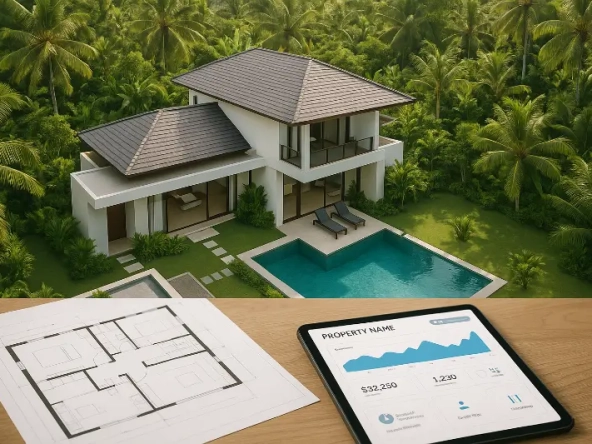Thinking of putting your money into commercial real estate? It can be a smart move. Commercial real estate Investment means putting your money into properties like offices, warehouses, retail shops, or even apartment buildings, basically, spaces used for business.
It can bring in solid income and grow your wealth over time. But just like any investment, it’s not without risks. Markets shift. Tenants leave. Repairs get expensive. If you’re not careful, your capital, the money you worked hard for, can take a serious hit.
That’s why risk management isn’t just smart, it’s necessary. You’re not just buying property; you’re building a safety net.
This guide breaks down how to do that. We’ll walk through the major risks that come with commercial real estate and how to prepare for them. You’ll learn simple, effective strategies to protect your investment and avoid common (and costly) mistakes. Whether you’re just starting out or already own a few properties, this is your playbook for staying smart and staying safe.

We hope you enjoy this article.
Need more expert guidance and hundreds of top properties in Bali?
Start With a Solid Due Diligence Checklist

Okay, before you throw a big chunk of your money at a new commercial property, take a breath. You need to check everything. That’s what due diligence means. In commercial real estate, due diligence is like doing a deep clean before you move into a new place. You want to know what’s broken, what works, and if anything smells funny behind the scenes.
You’re not just buying a building. You’re buying its problems too, unless you catch them first.
Due diligence is your safety net. It helps you avoid nasty surprises and big, expensive regrets. It’s not fun and sexy, but it will save your wallet.
Key components of a due diligence checklist
Property Condition
This one’s easy to miss, but super important. Get a full inspection done by a pro. You need reports on the roof, plumbing, walls, wiring, drainage, and even the paint. Look at the repair history too. If the building’s falling apart behind the walls, you’ll be paying for it soon. And it won’t be cheap.
Legal Review
Is the property allowed to be used the way you want? That’s zoning. Has someone else laid claim to the land? That’s the title. Are the lease agreements solid or full of tenant-friendly loopholes? If you don’t know what to look for here, bring in a lawyer. A good legal review can catch stuff that turns a good-looking deal into a ticking time bomb.
Financials
Open the books. Has the property been making money? Or losing it? Check cash flow reports, past rent collections, tax bills, utility costs, maintenance fees, everything. If the numbers don’t make sense, walk away. A bad deal with pretty pictures is still a bad deal.
Property Location
Where the building sits matters more than how it looks. Is the area growing, stable, or dying? Are new roads, malls, or housing projects planned nearby? That stuff can make or break future value. Also, check foot traffic, parking, noise levels, and nearby businesses. Don’t skip this. Great buildings in bad locations stay empty.
Here’s the bottom line: due diligence is boring, but losing your investment is worse. Doing the hard checks early protects your money and gives you leverage to negotiate. You might find something that knocks the price down, or something that makes you run.
Either way, that checklist is your best friend. Use it every time. Don’t guess, don’t assume. Be sharp. Be nosy. And most of all, don’t buy blind.
Conduct Thorough Market Analysis: Steps You Can’t Skip
Market analysis isn’t just some fancy report investors toss around. It’s your decision-making GPS. It helps you figure out whether the property you’re eyeing actually fits into the bigger picture and whether it’ll still make sense a year or two down the road. Skip it, and you’re investing with a blindfold on. That’s how money disappears.
Key components of a due diligence checklist
- Define the property type and market area
Start simple. What kind of property are you looking at, retail? Office? Industrial? Multifamily? Each one moves differently in the market. Then, get clear on the area. Are you looking at a specific neighbourhood, city, or wider region? Draw the boundaries so your data means something. Don’t analyse “Bali” if the building is in a sleepy little corner of Gianyar. - Analyse local supply and demand
Now look at what’s out there. How many properties like this one are available? Are there lots of empty units, or is everything snatched up fast? More importantly, what does demand look like? Are businesses moving in or moving out? Are people fighting over good space or avoiding it altogether? This tells you how competitive things are and whether your property is going to sit empty or stay in demand. - Review economic indicators
Here’s where it gets real. Look at job growth, population trends, infrastructure projects, and business activity. If more people are moving in and more jobs are popping up, that’s a good sign. If things are slowing down, think twice. Commercial real estate is tightly tied to the economy; no jobs, no rent. - Study comparable properties and rental rates
Time to do some snooping. Check out properties similar to yours. What do they rent for? How long do they stay vacant? Are they being sold at higher or lower prices than a year ago? If your target building is priced way above the rest, or the rent you think you can charge is off, you’ve got a problem. - Forecast trends and potential risks
No one has a crystal ball, but you can make smart guesses. Are there new developments coming that could flood the market with supply? Are interest rates rising, making loans more expensive? Could remote work trends kill demand for office space in your area? Spot these risks early so you can plan around them, or walk away if it’s not worth it.
Market analysis is non-negotiable. It’s what separates blind bets from smart investments. Even if you love the property, even if the numbers seem great if the market doesn’t support it, don’t do it. Data is your friend. Use it. Keep your eyes open, your questions sharp, and your money protected.
Tenant Screening Tips to Minimise Income Risk
Tenants are the engine of your commercial property. No tenants, no income. Bad tenants? Still no income, plus a whole bunch of headaches. So if you’re serious about protecting your money, tenant screening isn’t optional. It’s step one in making sure your shiny new property doesn’t turn into a slow-motion financial disaster.
You’re not just trying to fill a space. You’re choosing who’s going to pay your bills, treat your property with respect, and stick around long enough to make it all worth it. A good tenant can make your life easy. A bad one? Expensive legal battles, long vacancies, unpaid rent, and a mess to clean up literally and financially.
Tenant screening tips
- Verify credit history and financial stability
This is where the rubber meets the road. Don’t just take their word for it; look at credit reports, bank statements, and financial records. Are they paying other bills on time? Can they afford the rent without blinking? If it’s a business, check the profit and loss statements. If the numbers look shaky now, imagine what could happen in a downturn. - Check business history and industry trends
Even if the tenant seems great today, you want to know where they’re headed. Has their business been around long? Is their industry growing, or struggling? A restaurant in a high-turnover area might be risky. A local pharmacy with a 10-year track record? Much safer. You’re not just renting a space, you’re betting on their ability to stay in business. - Request personal or corporate guarantees
This is your safety net. If things go south, you want something to fall back on. A personal guarantee means the business owner is on the hook if the business fails. A corporate guarantee works if the tenant is backed by a larger, more stable parent company. These aren’t just legal details; they’re leverage. - Look for long-term leases with escalation clauses
Short leases mean high turnover and more risk. Long-term leases = stability. Even better? Escalation clauses. These are built-in rent increases over time, which help you keep up with inflation and rising expenses. It’s a smart way to lock in income while protecting your future returns. - Assess tenant mix (for multi-unit properties)
If you’re buying a retail centre or office complex, don’t just look at one tenant; look at the mix. Do they complement each other? Or do they compete and undercut one another? A strong mix brings in foot traffic and balance. Too many similar businesses in one spot can cause chaos when one fails.
Red flags to watch out for
- Gaps in rental or business history
- Refusal to share financials
- Poor credit or big debts
- No clear business plan or sketchy industry
- Wanting too much flexibility in the lease
All in all, don’t rent to just anyone. Screen like your investment depends on it, because it does. Ask questions. Be nosy. Trust the numbers, not the pitch. A solid tenant is your biggest layer of protection in commercial real estate. Choose wisely.
Use Diversification to Spread Risk in Real Estate
In real estate investing, diversification is a process that happens when you pour all your money into one property type, one location, or one tenant. If that one thing goes sideways, so does your whole investment. That’s where diversification comes in. It’s a fancy word for a very smart move: spreading your money around so no single misstep wrecks your whole game.
So, what is diversification in real estate?
At its core, diversification means building a portfolio that includes different types of assets, in different places, under different conditions. It’s like not ordering the same dish at every restaurant; you’re trying different flavours, so if one turns out to be a disaster, the others might still leave you full and happy. In real estate, this strategy helps balance your wins and losses, keeping your overall investment more stable, even when the market gets a little moody.
Types of diversification strategies:
Let’s break down how you can do this diversification thing. There’s more than one way to slice the pie.
- Asset type (retail, office, industrial, mixed-use)
This is where the rubber meets the road. Don’t just take their word for it; look at credit reports, bank statements, and financial records. Are they paying other bills on time? Can they afford the rent without blinking? If it’s a business, check the profit and loss statements. If the numbers look shaky now, imagine what could happen in a downturn. - Geography (different cities/regions)
Imagine you’ve got all your properties in one city. And that city gets hit with a natural disaster, a new zoning law, or a local economic downturn. Ouch. But if you’ve got properties spread across cities, or better yet, across different regions, one local crisis won’t take your entire portfolio down with it. It’s real estate’s version of “don’t put all your chips on one roulette number.” - Lease terms (short-term vs long-term)
This one’s all about cash flow and flexibility. Long-term leases give you steady, predictable income. That’s your slow-and-steady tortoise. Short-term leases, on the other hand, can give you agility, like the hare, quick to adjust to market changes. You want a mix of both. That way, you’re not too locked in, but also not left scrambling if tenants bounce. - Tenant profile (industry mix)
You don’t want to rent all your spaces to the same type of business. If every single tenant is in, say, retail, and retail takes a dip, so does your income. But if you have a law firm here, a gym there, maybe a warehouse for an e-commerce brand over there, you’re not dependent on one industry’s success. Spread the risk by mixing up your tenant pool.
Here’s the bottom line: when one part of your portfolio struggles, others might stay steady or even shine. Diversification keeps your income stream from drying up all at once. It softens the blows, evens out the swings, and keeps your money working smarter, not harder.
So, diversification is your secret weapon. It keeps your real estate game strong, even when the market throws a tantrum.
Ongoing Risk Monitoring & Mitigation
Buying a commercial property isn’t the finish line—it’s just the beginning. Once you’re in the game, you have to stay sharp. Real estate doesn’t sit still. Markets shift. Tenants leave. New rules pop up. If you’re not watching closely, small problems can snowball into expensive ones.
That’s why ongoing risk monitoring matters. It’s about checking in, adjusting fast, and staying one step ahead. You don’t want to react to risk—you want to spot it before it bites.
Let’s break this down into the stuff you need to keep an eye on regularly.
Market Intelligence Updates
Keep your finger on the pulse. Don’t assume your building will always perform the way it did last year.
Start with your KPIs—your key performance indicators:
- NOI (Net Operating Income): Are you actually making money after expenses?
- Occupancy rate: How full is your building? Empty units = lost income.
- Tenant turnover: Are people staying, or are you constantly finding new tenants (which costs time and money)?
Track these monthly or quarterly. If numbers dip, act fast. Don’t wait until the damage is done
Lease Management & Tenant Relations
Leases are living things. They need attention. Stay on top of expiry dates, rent escalations, renewal windows, and any clauses that might trip you up in hard times.
Talk to your tenants. Don’t ghost them. Build good relationships so they’ll talk to you early if they’re struggling. That way, you can work out solutions before things go bad.
Subscribe to local broker reports, follow economic trends, and use real estate data services to stay informed about your area. If the market starts shifting, you’ll know before it hits your balance sheet.
Insurance & Hedging Strategies
Insurance isn’t a box to tick and forget. Review it often.
- Do you have property insurance that covers today’s value?
- What about liability coverage in case someone slips and sues you?
- Got business interruption insurance if something shuts you down for a while?
Also, think about hedging financial risks. Consider interest-rate caps if you’re on a variable loan. In a downturn, having rent relief policies in place can protect tenant relationships and your future income.
Exit Planning & Contingencies
Always have a Plan B and C. What happens if you need to get out?
Run a hold vs. sell analysis every year. Sometimes it makes more sense to cash out and reinvest elsewhere. Look at secondary markets if your main area starts feeling shaky.
Have a distress sale protocol in place, just in case. It sounds harsh, but it’s better to know your exit options now than to panic later.
Hold vs. sell analysis, secondary markets, distress sale protocols
Bottom line? Real estate isn’t a “set it and forget it” kind of deal. Keep your eyes open. Keep your data tight. Stay connected to your tenants. And always have a backup plan. The more proactive you are, the harder it is for risk to sneak up on you.
Bonus: Commercial Real Estate Investment Risk Management Tips
You’ve got the big stuff down, due diligence, tenant checks, diversification, all that good stuff. But let’s not stop there. There are a few bonus moves smart investors use to take their risk protection game to the next level. These are easy to overlook but can save you big when things don’t go as planned (and trust us, sometimes they don’t).
Get the right insurance coverage
Let’s keep this simple: if you don’t have proper insurance, one bad day could wipe out years of progress. It’s not fun to think about storms, lawsuits, or major repairs—but it’s worse to face them unprepared.
Here’s what you’ll want to look into:
- Property insurance: Covers damage to the building—fire, storms, theft, you name it.
- Liability insurance: If someone gets hurt on your property, you don’t want to pay those medical bills out of pocket.
- Business interruption insurance: Let’s say the property becomes unusable for a while (maybe a flood or power failure). This insurance helps cover the income you lose during downtime.
Don’t cheap out here. Talk to someone who actually understands commercial real estate. Make sure you know what’s covered, what’s not, and how fast payouts happen. Your future self will thank you.
Work with experienced real estate agents and property managers
Now, this is especially true if you’re investing somewhere you don’t fully understand, like buying a villa in Bali. It might look like paradise, but the local laws, zoning rules, and tenant behaviours can be very different from what you’re used to. You don’t want to make rookie mistakes with big money on the line.
Here’s the fix: work with people who know what they’re doing.
In Bali, trusted names like Balitecture Realty and Spacious Bali can help you find the right investment property and manage it properly once you buy. They’ve already made the mistakes and learned from them, so you don’t have to.
- A smart agent helps you pick the right area, negotiate better deals, and avoid legal landmines.
- A solid property manager keeps your tenants happy, handles repairs, deals with permits, and watches your bottom line.
You’re still the owner, but with a powerful team behind you, you don’t have to micromanage every detail.
Build an emergency reserve fund
This one’s boring but vital. Things break. Tenants fall behind on rent. Roofs leak. Plumbing explodes. Even in the best property in the best location, stuff can go sideways.
If you don’t have extra cash set aside, you’ll end up scrambling—taking out expensive loans, dipping into personal funds, or worst of all, selling under pressure.
The smart move? Keep 3 to 6 months’ worth of property expenses stashed in a separate emergency fund. This includes mortgage payments, maintenance costs, taxes, and insurance. You might not need it often, but when you do, it can save you from disaster.
Recap
Now let’s do a quick rundown of the key strategies we’ve covered in this guide. These are the core tools you’ll use to manage risk and protect your investment:
- Due diligence: Always do a deep dive before you buy. Inspect the building, review financials, check legal docs, and understand the area. This is where you catch red flags early.
- Market analysis: Study the local market and economy. Are people moving in or out? Are businesses growing? What’s the rental demand? This helps you invest in the right place at the right time.
- Tenant screening: Good tenants = steady income. Bad tenants = stress and unpaid rent. Always check credit, business stability, and lease history. Don’t rent to just anyone.
- Diversification: Don’t bet everything on one deal. Spread your money across different property types, locations, lease structures, and industries. It makes your portfolio stronger.
- Ongoing risk monitoring: Track your performance. Watch your KPIs like NOI, occupancy rate, and tenant turnover. Stay alert to legal, financial, and market changes. Adjust before things go south.
- Insurance, management, and emergency planning: Get good coverage, hire experts, and build a rainy-day fund. These are your safety nets when life throws a curveball.
Final Thoughts
Let’s be real: you can’t erase risk from commercial real estate. No one can. There’s always going to be something: markets shift, tenants leave, buildings need repairs. That’s just the game.
But here’s the difference between winning and losing in this business: the winners manage risk well. They don’t panic when things go wrong because they’ve already planned for it. They know their numbers, trust their team, and think a few steps ahead.
So if you’re serious about protecting your money and growing your portfolio, don’t rely on luck. Use the strategies in this guide. Stay curious. Stay sharp. And treat every deal like it matters, because it does.
In real estate, risk isn’t something you fear. It’s something you prepare for. And with the right plan in place, you don’t just survive it, you turn it into an opportunity.
Need More Expert Guidance in Buying Property in Bali?

As a leading authority in the real estate industry, Balitecture provides complete assistance throughout the process. A team of experts specializing in A-Z property services is committed to helping you every step of the way.
Set a free consultation with us!
We also have you covered with extensive property listings. This includes Bali land for sale, villas for sale, villas for rent, and other properties available for lease and sale. Plus, villa management can help you make the most of generating income from your property.
Discover Bali villas for lease and sale here.
Discover Bali lands for lease and sale here.
Find the best features and benefits of villa management here.




